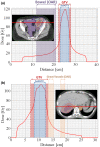Radiation treatment planning study to investigate feasibility of delivering Immunotherapy in Combination with Ablative Radiosurgery to Ultra-High DoSes (ICARUS)
- PMID: 33626240
- PMCID: PMC7984482
- DOI: 10.1002/acm2.13204
Radiation treatment planning study to investigate feasibility of delivering Immunotherapy in Combination with Ablative Radiosurgery to Ultra-High DoSes (ICARUS)
Abstract
Purpose: Immune checkpoint inhibitors improve survival in metastatic diseases for some cancers. Multisite SBRT with pembrolizumab (SBRT + Pembro) was shown to be safe with promising local control using biologically effective doses (BEDs) = 95-120 Gy. Increased BED may improve response rate; however, SBRT doses are limited by surrounding organs at risk (OARs). The purpose of this work was to develop and validate methods for safe delivery of ultra-high doses of radiation (BED10 > 300) to be used in future clinical trials.
Methods and materials: The radiation plans from 15 patients enrolled on a phase I trial of SBRT + pembro were reanalyzed. Metastatic disease sites included liver (8/15), inguinal region (1/15), pelvis (2/15), lung (1/15), abdomen (1/15), spleen (1/15), and groin (1/15). Gross tumor volumes (GTVs) ranged from 80 to 708 cc. Following the same methodology used in the Phase I trial on which these patients were treated, GTVs > 65 cc were contracted to a 65 cc subvolume (SubGTV) resulting in only a portion of the GTV receiving prescription dose. Volumetric modulated arc therapy (VMAT) was used to plan treatments BED10 = 360 Gy. Plans utilizing both 6FFF and 10FFF beams were compared to clinical plans delivering BED10 = 112.50 Gy. The target primary goal was V100% > 95% with a secondary goal of V70% > 99% and OAR objectives per the trial. To demonstrate feasibility, plans were delivered to a diode array phantom and evaluated for fidelity using gamma analysis.
Results: All 30 plans met the secondary coverage goal and satisfied all OAR constraints. The primary goal was achieved in 12/15 of the 6FFF plans and 13/15 of the 10FFF plans. Average gamma analysis passing rate using criteria of 3% dose difference and 3, 2, and 1 mm were 99.1 1.0%, 98.5 1.6%, and 95.1 3.8%, respectively.
Conclusion: Novel VMAT planning approaches with clinical treatment planning software and linear accelerators prove capable of delivering radiation doses in excess of 360 Gy BED10 to tumor subvolumes, while maintaining safe OAR doses.
Keywords: SBRT; immunotherapy; treatment planning; ultra-high dose.
© 2021 The Authors. Journal of Applied Clinical Medical Physics published by Wiley Periodicals, Inc. on behalf of American Association of Physicists in Medicine.
Conflict of interest statement
SJC — Consultancy: RefleXion Medical; Salary: Astellas Pharma (Spouse); Research Support: (all to institution for clinical trials unless noted) Bristol‐Myers Squibb, Merck, EMD Serono, RefleXion.
Figures




References
MeSH terms
LinkOut - more resources
Full Text Sources
Other Literature Sources
Medical
Miscellaneous

